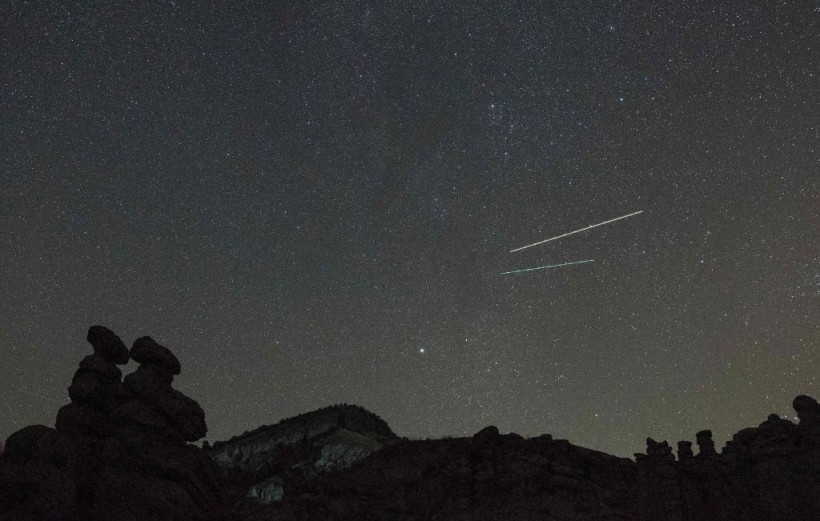Stargazers with a clear view to the east will be in luck, as an annual meteor shower will light up almost the precise point where four planets are aligning close together this weekend.
Saturn, Mars, Venus, and Jupiter will appear like "mismatched spotlights in the night sky" on Sunday Stuff.nz reported. Later that night, Eta Aquarid will join the festivities.

Perseid meteorites streak over the stone dools near the village of Kuklica in the municipality of Kratovo, Northern Macedonia, an area of naturally formed stone pillars that resemble humans, on August 13, 2021.
How to See Eta Aquariids Meteor Shower As Earth Passes The Trail Left By Halley's Comet
ley's Comet. The "periodic" comet is the most famous in history and it returns to Earth every 75 years, making it possible for one to see it twice in their lifetime, Space. com reported.
It is named Eta Aquariids meteor shower because it appears annually in the constellation of Aquarius.
You'll have to wait until the radiant rises to observe the Eta Aquariids; otherwise, the Earth's body will block your view. According to The Conversation, the Eta Aquariid radiant rises in the east at roughly 1:30 to 2 a.m. local time, which is fortunate for us in the southern hemisphere.
While Eta Aquariid meteors may be seen everywhere in the sky, the optimal spot for seeing the most meteors is roughly 45 degrees to the left or right of the radiant itself.
Fortunately, another stunning sight in the early sky awaits us this year. Saturn, Mars, Jupiter, and Venus will all be in a straight line. Look 45 degrees to the left or right of this line of planets for the finest meteor spectacle.
Visit the Stellarium planetarium website, choose your location, then forward the date and time to the morning of May 7 to see how the planets and radiant will rise from your position. You may watch Aquarius and the planets rise from the comfort of your computer if you switch on "constellations" and "constellations art" (at the bottom of the screen).
ALSO READ: How Often Do Shooting Stars Appear? Experts Say Meteor Showers Are Common Than Most People Thought
However, there is a word of caution. Meteors are similar to buses in that if you expect 30 per hour, you may easily wait 10 minutes and see nothing before three appear at once. Make sure you're dressed warmly enough to spend at least half an hour, if not more, under the stars.
Eta Aquarid Meteor Shower 2022 As Shared Online
Meanwhile, people on social media are using the hashtags #EtaAquarids, #EtaAquaridMeteorShower, #MeteorShower, and #Meteor to share photographs of suspected meteor sightings. Here are a few of our personal favorites:
Glass House Mountains in Queensland, Australia
The Milky Way core and a sneaky small meteor from the ETA Aquarids Meteor Shower, which peaks on May 6/7 from Glass House Mountains in Queensland, Australia, were captured by Instagram user @jalynphotos. Unfortunately, the weather projections for the East Coast do not appear promising. Nonetheless, the Instagram user was grateful for the opportunity.
San Pedro de Atacama, Chile
Instagram user @peterhoralek on time-lapsed the first Eta-Aquarid meteor over San Pedro de Atacama, Chile. He just caught a massive flame. A planetary procession may also be observed in the Zodiacal Light column, as well as the magnificent southern Milky Way. My wide-angle lens couldn't tell the difference between Venus and Jupiter since they were so close together.
Japan
Meanwhile, Instagram user @dot_moica provided this beautiful image of the Milky Way, which shows the ETA Aquarids Meteor Shower in Japan.
If you get up early on Friday, you'll be rewarded with a beautiful sight of Venus, Jupiter, Mars, and Saturn in the southeast sky, which you may post on social media.
RELATED ARTICLE: Eta Aquariids Meteor Shower 2022: How to See Debris from Halley's Comet Through the Sky This Week
Check out more news and information on Space in Science Times.














